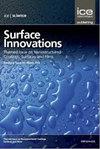Stability of cold plasma improved wettability and adhesive property of polytetrafluoroethylene surface
IF 2.7
4区 材料科学
Q3 CHEMISTRY, PHYSICAL
引用次数: 0
Abstract
In this paper, we investigate the wettability change of APCP-treated PTFE surfaces with time under different storage temperatures and pressures, and the results indicate that low temperature can hinder the wettability recovery. After storing for 5 days, WCA of PTFE stored under room temperature (25°C) recovered from 19 ± 2° to 54 ± 2°, while the WCA of PTFE stored under low temperature (−10°C) just increased to 42 ± 3°. Then, the mechanism contributing to the slower wettability recovery was investigated by analyzing surface chemical compositions via X-ray photoelectron spectroscopy (XPS) and observing surface morphologies using atomic force microscope (AFM). After 15 days storage, the contents of O and N decreased obviously, while F content increased. The F content of sample stored under low temperature was 20% less than that stored under room temperature. By contrast, surface micro-morphologies remained unchanged during storage, and the surface roughness Ra of each sample was around 7 nm. Finally, peel strength tests were conducted on APCP-treated PTFE surfaces stored under different temperatures, and the surfaces stored under low temperature maintained better adhesive property; after 15 days of storage, the adhesive strength could still reach 400 N/m, which was 376% higher than that of the untreated surface. The research results are expected to significantly facilitate practical applications of APCP modification and PTFE surfaces.冷等离子体的稳定性提高了聚四氟乙烯表面的润湿性和粘接性能
在本文中,我们研究了APCP处理的PTFE表面在不同储存温度和压力下的润湿性随时间的变化,结果表明低温会阻碍润湿性的恢复。储存5天后,室温(25°C)下储存的PTFE的WCA从19±2°恢复到54±2°,而低温(−10°C)储存的PTFE WCA仅增加到42±3°。然后,通过X射线光电子能谱(XPS)分析表面化学成分和原子力显微镜(AFM)观察表面形貌,研究了导致润湿性恢复较慢的机制。贮藏15d后,O、N含量明显下降,F含量增加。低温保存的样品的F含量比室温保存的样品低20%。相反,在储存过程中,表面微观形态保持不变,每个样品的表面粗糙度Ra约为7 nm。最后,对不同温度下储存的APCP处理的PTFE表面进行了剥离强度测试,低温下储存的表面保持了较好的粘合性能;储存15天后,粘合强度仍然可以达到400 N/m,比未处理表面的N/m高376%。研究结果有望显著促进APCP改性和PTFE表面的实际应用。
本文章由计算机程序翻译,如有差异,请以英文原文为准。
求助全文
约1分钟内获得全文
求助全文
来源期刊

Surface Innovations
CHEMISTRY, PHYSICALMATERIALS SCIENCE, COAT-MATERIALS SCIENCE, COATINGS & FILMS
CiteScore
5.80
自引率
22.90%
发文量
66
期刊介绍:
The material innovations on surfaces, combined with understanding and manipulation of physics and chemistry of functional surfaces and coatings, have exploded in the past decade at an incredibly rapid pace.
Superhydrophobicity, superhydrophlicity, self-cleaning, self-healing, anti-fouling, anti-bacterial, etc., have become important fundamental topics of surface science research community driven by curiosity of physics, chemistry, and biology of interaction phenomenon at surfaces and their enormous potential in practical applications. Materials having controlled-functionality surfaces and coatings are important to the manufacturing of new products for environmental control, liquid manipulation, nanotechnological advances, biomedical engineering, pharmacy, biotechnology, and many others, and are part of the most promising technological innovations of the twenty-first century.
 求助内容:
求助内容: 应助结果提醒方式:
应助结果提醒方式:


